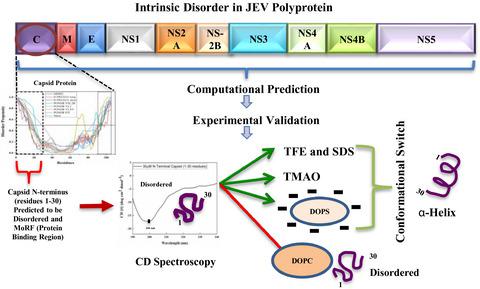Our official English website, www.x-mol.net, welcomes your feedback! (Note: you will need to create a separate account there.)
Japanese encephalitis virus - exploring the dark proteome and disorder-function paradigm.
The FEBS Journal ( IF 5.4 ) Pub Date : 2020-05-30 , DOI: 10.1111/febs.15427 Taniya Bhardwaj 1 , Kumar Udit Saumya 1 , Prateek Kumar 1 , Nitin Sharma 1 , Kundlik Gadhave 1 , Vladimir N Uversky 2, 3 , Rajanish Giri 1
The FEBS Journal ( IF 5.4 ) Pub Date : 2020-05-30 , DOI: 10.1111/febs.15427 Taniya Bhardwaj 1 , Kumar Udit Saumya 1 , Prateek Kumar 1 , Nitin Sharma 1 , Kundlik Gadhave 1 , Vladimir N Uversky 2, 3 , Rajanish Giri 1
Affiliation

|
Japanese encephalitis virus (JEV) is one of the major causes of viral encephalitis all around the globe. Approximately 3 billion people in endemic areas are at risk of Japanese encephalitis. To develop a wholistic understanding of the viral proteome, it is important to investigate both its ordered and disordered proteins. However, the functional and structural significance of disordered regions in the JEV proteome has not been systematically investigated as of yet. To fill this gap, we used here a set of bioinformatics tools to analyze the JEV proteome for the predisposition of its proteins for intrinsic disorder and for the presence of the disorder‐based binding regions (also known as molecular recognition features, MoRFs). We also analyzed all JEV proteins for the presence of the probable nucleic acid‐binding (DNA and RNA) sites. The results of these computational studies are experimentally validated using JEV capsid protein as an illustrative example. In agreement with bioinformatic analysis, we found that the N‐terminal region of the JEV capsid (residues 1–30) is intrinsically disordered. We showed that this region is characterized by the temperature response typical for highly disordered proteins. Furthermore, we have experimentally shown that this disordered N‐terminal domain of a capsid protein has a noticeable ‘gain‐of‐structure’ potential. In addition, using DOPS liposomes, we demonstrated the presence of pronounced membrane‐mediated conformational changes in the N‐terminal region of JEV capsid. In our view, this disorder‐centric analysis would be helpful for a better understanding of the JEV pathogenesis.
中文翻译:

日本脑炎病毒-探索黑暗蛋白质组和障碍功能范式。
日本脑炎病毒(JEV)是全球病毒性脑炎的主要原因之一。流行地区约30亿人有患日本脑炎的危险。为了发展对病毒蛋白质组的全面了解,重要的是研究其有序和无序的蛋白质。但是,到目前为止,尚未对JEV蛋白质组中无序区域的功能和结构意义进行系统研究。为了填补这一空白,我们在这里使用了一组生物信息学工具来分析JEV蛋白质组,以了解其内在疾病的蛋白质易感性以及是否存在基于疾病的结合区(也称为分子识别特征,MoRF)。我们还分析了所有JEV蛋白中可能存在的核酸结合(DNA和RNA)位点。这些计算研究的结果以JEV衣壳蛋白为例进行了实验验证。与生物信息学分析一致,我们发现JEV衣壳的N末端区域(残基1-30)本质上是无序的。我们表明,该区域的特征是高度无序蛋白的典型温度响应。此外,我们已经通过实验证明衣壳蛋白的这种无序的N末端结构域具有明显的“结构增益”潜力。此外,使用DOPS脂质体,我们证明了JEV衣壳的N端区域存在明显的膜介导的构象变化。我们认为,这种以疾病为中心的分析将有助于更好地了解JEV发病机理。
更新日期:2020-05-30
中文翻译:

日本脑炎病毒-探索黑暗蛋白质组和障碍功能范式。
日本脑炎病毒(JEV)是全球病毒性脑炎的主要原因之一。流行地区约30亿人有患日本脑炎的危险。为了发展对病毒蛋白质组的全面了解,重要的是研究其有序和无序的蛋白质。但是,到目前为止,尚未对JEV蛋白质组中无序区域的功能和结构意义进行系统研究。为了填补这一空白,我们在这里使用了一组生物信息学工具来分析JEV蛋白质组,以了解其内在疾病的蛋白质易感性以及是否存在基于疾病的结合区(也称为分子识别特征,MoRF)。我们还分析了所有JEV蛋白中可能存在的核酸结合(DNA和RNA)位点。这些计算研究的结果以JEV衣壳蛋白为例进行了实验验证。与生物信息学分析一致,我们发现JEV衣壳的N末端区域(残基1-30)本质上是无序的。我们表明,该区域的特征是高度无序蛋白的典型温度响应。此外,我们已经通过实验证明衣壳蛋白的这种无序的N末端结构域具有明显的“结构增益”潜力。此外,使用DOPS脂质体,我们证明了JEV衣壳的N端区域存在明显的膜介导的构象变化。我们认为,这种以疾病为中心的分析将有助于更好地了解JEV发病机理。

























 京公网安备 11010802027423号
京公网安备 11010802027423号